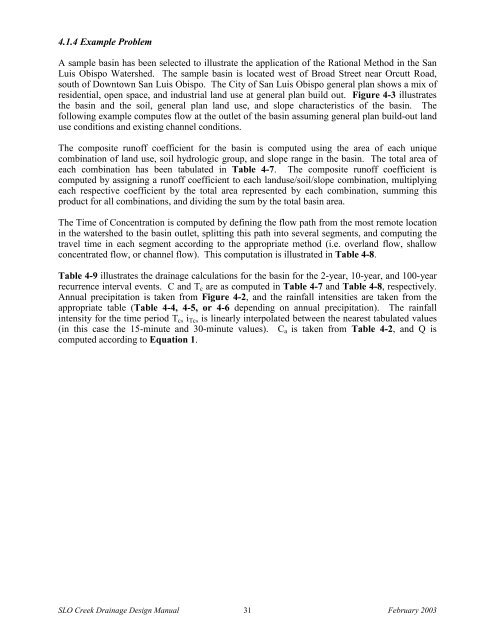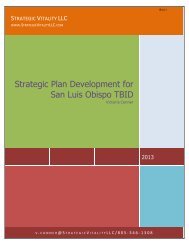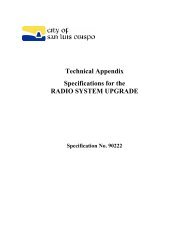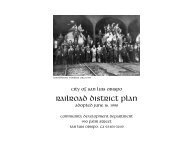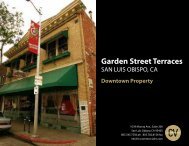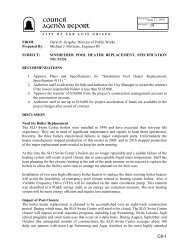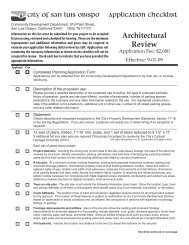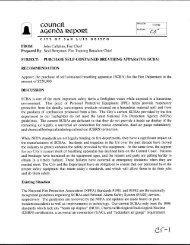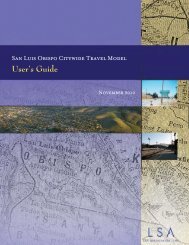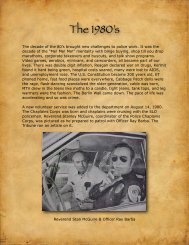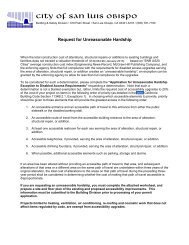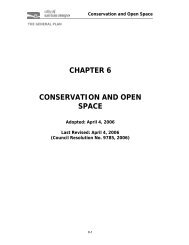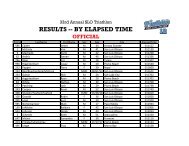Drainage Design Manual - the City of San Luis Obispo
Drainage Design Manual - the City of San Luis Obispo
Drainage Design Manual - the City of San Luis Obispo
Create successful ePaper yourself
Turn your PDF publications into a flip-book with our unique Google optimized e-Paper software.
4.1.4 Example ProblemA sample basin has been selected to illustrate <strong>the</strong> application <strong>of</strong> <strong>the</strong> Rational Method in <strong>the</strong> <strong>San</strong><strong>Luis</strong> <strong>Obispo</strong> Watershed. The sample basin is located west <strong>of</strong> Broad Street near Orcutt Road,south <strong>of</strong> Downtown <strong>San</strong> <strong>Luis</strong> <strong>Obispo</strong>. The <strong>City</strong> <strong>of</strong> <strong>San</strong> <strong>Luis</strong> <strong>Obispo</strong> general plan shows a mix <strong>of</strong>residential, open space, and industrial land use at general plan build out. Figure 4-3 illustrates<strong>the</strong> basin and <strong>the</strong> soil, general plan land use, and slope characteristics <strong>of</strong> <strong>the</strong> basin. Thefollowing example computes flow at <strong>the</strong> outlet <strong>of</strong> <strong>the</strong> basin assuming general plan build-out landuse conditions and existing channel conditions.The composite run<strong>of</strong>f coefficient for <strong>the</strong> basin is computed using <strong>the</strong> area <strong>of</strong> each uniquecombination <strong>of</strong> land use, soil hydrologic group, and slope range in <strong>the</strong> basin. The total area <strong>of</strong>each combination has been tabulated in Table 4-7. The composite run<strong>of</strong>f coefficient iscomputed by assigning a run<strong>of</strong>f coefficient to each landuse/soil/slope combination, multiplyingeach respective coefficient by <strong>the</strong> total area represented by each combination, summing thisproduct for all combinations, and dividing <strong>the</strong> sum by <strong>the</strong> total basin area.The Time <strong>of</strong> Concentration is computed by defining <strong>the</strong> flow path from <strong>the</strong> most remote locationin <strong>the</strong> watershed to <strong>the</strong> basin outlet, splitting this path into several segments, and computing <strong>the</strong>travel time in each segment according to <strong>the</strong> appropriate method (i.e. overland flow, shallowconcentrated flow, or channel flow). This computation is illustrated in Table 4-8.Table 4-9 illustrates <strong>the</strong> drainage calculations for <strong>the</strong> basin for <strong>the</strong> 2-year, 10-year, and 100-yearrecurrence interval events. C and T c are as computed in Table 4-7 and Table 4-8, respectively.Annual precipitation is taken from Figure 4-2, and <strong>the</strong> rainfall intensities are taken from <strong>the</strong>appropriate table (Table 4-4, 4-5, or 4-6 depending on annual precipitation). The rainfallintensity for <strong>the</strong> time period T c , i Tc , is linearly interpolated between <strong>the</strong> nearest tabulated values(in this case <strong>the</strong> 15-minute and 30-minute values). C a is taken from Table 4-2, and Q iscomputed according to Equation 1.SLO Creek <strong>Drainage</strong> <strong>Design</strong> <strong>Manual</strong> 31 February 2003


